You also want an ePaper? Increase the reach of your titles
YUMPU automatically turns print PDFs into web optimized ePapers that Google loves.
Franco Sciannameo recalls his association with the grand seigneur of<br />
twentieth-century Italian music in an interview with Luciano Martinis<br />
and Agnese Toniutti. Video recorded at Fondazione Scelsi in Rome on<br />
February 18, 2010.<br />
The Birth of a Masterpiece<br />
Franco Sciannameo<br />
Introduction<br />
The name of the Italian composer Giacinto Scelsi (born 1905 in<br />
La Spezia, died 1988 in Rome) still means little to audiences worldwide,<br />
despite the considerable amount of interest which his music has awakened<br />
in recent years. For some people, though, myself included, Scelsi’s has been a<br />
household name for a long time.<br />
My association with Scelsi began in the late 1950s, when as a<br />
violin major at the Conservatorio di Musica Santa Cecilia in Rome I spent<br />
many hours browsing the stock of the De Santis music establishment in<br />
Via del Corso, a few blocks away from the Conservatorio. I took notes<br />
about what interested me and of the scores I wished to purchase as<br />
money became available. The Pocket Scores series of contemporary string<br />
quartets published by Universal Edition in Vienna was at the top of my<br />
‘most wanted’ list. The works of Berg, Schönberg, and Bartók, presented<br />
with photoportraits of the composers on the inside covers, were, for me, a<br />
‘must have’. Over the years I bought a lot of them, including an odd item,<br />
almost an ‘intruder’ in the Universal series, which had found its place on<br />
De Santis’s shelf just a quarter of an inch to the left of Schönberg: Giacinto<br />
Scelsi’s Quartetto per archi (1944), published by Edizioni De Santis in 1948.<br />
The typographical style of the publication was pretty much similar to the<br />
Viennese pocket scores; it even boasted a photo-portrait of Scelsi in which<br />
he strikingly resembled Béla Bartók. In addition, a list of Scelsi’s works,<br />
composed since 1934, also published by De Santis, adorned the book’s back<br />
cover. The music of the Quartetto, at first glance, looked just as complex and<br />
intriguing as Berg’s Lyric suite.<br />
‘Why does no one ever play it?’, I asked myself. Even my illustrious<br />
violin teacher, Arrigo Pelliccia, the man who had championed in Italy the<br />
76 77
concertos of Berg, Schönberg, Krenek and others, was not familiar with<br />
Scelsi’s music. ‘Some composers just have to wait for their turn; remember<br />
Beethoven’s late quartets. The Viennese public was convinced he had<br />
gone insane when it heard them for the first time!’, he said. It is also true,<br />
though, that many composers committed their most intimate and daring<br />
thoughts to the string quartet - at once a form, a genre, and an instrumental<br />
ensemble. Consider the enigmatic opening of Mozart’s ‘Dissonance’ Quartet,<br />
Beethoven’s late quartets, Schubert’s ‘Death and the maiden’ and, in the<br />
twentieth century, Bartók’s six quartets, Berg’s Lyric suite (whose hidden<br />
message was deciphered many year later), Shostakovich’s Quartet no.8, and<br />
the quartets of Sibelius, Janá˘cek, and others.<br />
Generally, the string quartet did not flourish in Italy. In the first<br />
half of the twentieth century, the most noticeable works were Respighi’s<br />
noble Quartetto dorico (1924), Alfano’s Secondo Quartetto (1927), and the<br />
poetic eight quartets of Gian Francesco Malipiero, dating from 1920 to 1964.<br />
Dallapiccola never tackled the form, and Petrassi approached it only in 1958.<br />
So it was even more surprising that Scelsi’s Quartetto, a major work composed<br />
in 1944, went unnoticed. I still have that score in my possession. Several<br />
exemplars have been part of the lending collections of some American<br />
public and university libraries since the work’s publication in 1948. They<br />
are still there, hidden on the shelves, just a quarter of an inch to the left of<br />
Schönberg.<br />
In the early 1960s I was asked by Edizioni De Santis to co-edit for<br />
publication a group of works for harpsichord and strings by Martini, Felici,<br />
and Guglielmi and, having become acquainted with the head of the firm,<br />
Renato De Santis, I asked him if he knew what had happened to Giacinto<br />
Scelsi. ‘That was some experience’, De Santis said. ‘That man was difficult to<br />
deal with; he did not know what he wanted. Fortunately, though, he financed<br />
the entire publishing process of his works, from engraving to printing, so<br />
there were no losses to the firm.’ ‘Was he financially well-off?’, I asked;<br />
De Santis replied, ‘Yes indeed, he is still financially well-off; he is Count<br />
Giacinto Scelsi d’Ayala Valva, the last scion of an ancient Sicilian family<br />
probably of Spanish ancestry. He lives like a recluse in his house on Via San<br />
Teodoro, overlooking the Roman Forum.’<br />
Months later I was invited by violinist Massimo Coen to join<br />
the Quartetto di Nuova Musica, a newly formed group specializing in the<br />
performance of contemporary music. There was much work available to<br />
us - premieres at the Venice Festival of Contemporary Music, a recording<br />
contract with RAI, a European tour and the prospect of a long-term<br />
collaboration with a certain Giacinto Scelsi, the composer of much string<br />
music (four quartets to date), who wished to have it recorded and performed<br />
worldwide. ‘Scelsi has the material means to do what he wishes’, said Coen.<br />
Count Giacinto Scelsi d’Ayala Valva, circa 1940<br />
78 79
Vieri Tosatti, circa 1947<br />
‘Vieri Tosatti, the well-known Roman composer strongly suggests that we<br />
take on the job; you should know that he too is involved in “editing” Scelsi’s<br />
works; in fact, he has been doing it since the late 1940s, when some of<br />
Scelsi’s compositions appeared in the De Santis catalogue.’<br />
And so, for me, the Scelsi mystery began to unfold.<br />
A meeting with Scelsi was set. The composer wished to meet each<br />
member of the quartet and talk about his philosophies and the spiritual<br />
reasons that had led him to change his compositional style and, indeed, his<br />
life-style altogether. His music, in fact, had changed dramatically in the past<br />
twenty years, from anguishly atonal to transparently microtonal, pervaded<br />
by all kinds of Eastern influences. He played some tapes for us, the Quartetto<br />
per archi, now called Quartetto no.l, performed by Quatuor de Paris; Xnoybis<br />
(1964), for unaccompanied violin, played by Devy Erlih; and the Quartetto<br />
no.2 (1961), performed by Societa Cameristica Italiana. The music of that<br />
piece, which employs some cumbersome copper mutes invented by Scelsi,<br />
sounded terrible to us! Midway through the listening, Salvatore, the cellist,<br />
bouncing off his chair, screamed into Scelsi’s face, ‘Questa e la pazzia! You are<br />
crazy, and your music is the reflection of it; you want all of us to become<br />
insane!’<br />
Needless to say, the meeting ended abruptly. The next time we met<br />
at Scelsi’s house we brought along a new cellist, an American woman who<br />
had landed in Rome on a Fulbright Scholarship a few years earlier to study<br />
with Enrico Mainardi. Donna was an excellent cellist and made no secret, to<br />
Scelsi’s amazement, that one of the job’s attractions was for her the fact that<br />
the composer was a real Count. Scelsi, sincerely amused by the statement (he<br />
had a soft spot for foreign ladies), gave all of us permission to address him<br />
as Count Scelsi; he did not like to be called Maestro. After all the quartet<br />
members passed Count Scelsi’s stringent scrutiny, finally, one day, the score<br />
and parts of Quartetto no.4 were distributed. We were given a few weeks<br />
to analyse the material prior to rehearsing it under the supervision of both<br />
Vieri Tosatti and Giacinto Scelsi.<br />
In the meantime, a string quartet from Hamburg gave a concert in<br />
Rome at the Goethe Institute. Its programme included Scelsi’s Quartetto<br />
no.2. We were invited to attend the concert, at which the Hamburg players<br />
performed honourably, and at the end of Scelsi’s piece the first violinist<br />
invited the composer, who was present in the hall, to stand and take a bow.<br />
An upset Scelsi, though, moved rapidly to front stage and in a stentorian<br />
yet agitated tone of voice declared that the instrumentalists’ interpretation<br />
did not correspond to his wishes; therefore he could not acknowledge the<br />
audience’s applause.<br />
80 81
The German foursome must have not understood Italian or the<br />
absurdity of Scelsi’s declaration, because one hour later they were the guests<br />
of honour at a reception held in Scelsi’s home. Elliott Carter was among the<br />
guests that evening, and upon learning that the Quartetto di Nuova Musica<br />
was working on Scelsi’s latest quartet, he said that some day he would hope<br />
that his two quartets (it was 1965) would be performed together with Scelsi’s,<br />
so fond was he of Scelsi’s music. Mr. Carter then added that Darius Milhaud<br />
also held Scelsi in high esteem.<br />
Quartetto no.4 (1964)<br />
As soon as we opened the beautifully copied score (identical to the<br />
present Salabert edition), we realised that this quartet was the proverbial<br />
‘different kettle of fish’. It was notated tablature-style, one pentagram<br />
for each string of each instrument, as if the string quartet were a single<br />
instrument with sixteen strings. Scelsi’s particular use of scordatura allows,<br />
in fact, the player to perform double and triple stops otherwise impossible<br />
under normal tuning.<br />
Problems typically inherent to this type of mistuning can be as<br />
serious as they are numerous. First, there are unbalanced pressures applied<br />
by the hyper- and tensionless strings on the belly of the instruments (one<br />
violin experienced a sound-post crack after a few days, and there were<br />
constant problems in keeping the cello’s high-A-stretched-to-C in tune).<br />
Next, different fingering systems had to be devised. And finally, the group<br />
had to establish standard pitch for quarter and three-quarter tones played<br />
below and above a given central note. Fortunately, Tosatti’s infallible ear<br />
could detect an ‘out-of-tune’ microtone in the midst of any situation.<br />
Rehearsals took place every other evening at Tosatti’s house for about a<br />
month. Tosatti conducted and took notes of any eventual adjustments made<br />
to the score, while Scelsi, keeping himself out of sight, was mostly concerned<br />
with the overall aesthetics of the piece. I remember him saying, ‘There is<br />
an arch somewhere in the piece which I want you to reach to; it should<br />
sound like the culmination of a chorale.’ But he was never clear where in<br />
the piece it was going to occur, and the notation in the score seemed unable<br />
to identify it. One evening the search for the elusive chorale leading to<br />
the quartet’s ‘golden’ moment finally revealed it, as Scelsi exclaimed from<br />
the other room, ‘É qui, é qui!’. It was there all along, in bar 167, triggered<br />
by a low pedal note in the cello, played fortissimo. We just were not getting<br />
enough into the center of the sound to strike the right note - we had not<br />
yet entered into the illusive third sonic dimension about which Scelsi was so<br />
adamant. That was indeed a moment of discovery which unlocked, for the<br />
four of us, the door to this complex man’s poetic. Luciano, our violist and<br />
most sceptical member of the group finally let himself remark, ‘You know, I<br />
really think that the Count is good! Il Conte é bravo!’.<br />
82 83
The Quartetto di Nuova Musica recorded Scelsi’s Quartetto no.4 in<br />
the autumn of 1965. Vieri Tosatti conducted the session which also included<br />
two compositions for soprano, string quartet and percussion belonging to<br />
Khoom (1962), a set of pieces for soprano and various instruments. Michiko<br />
Hirayama was the singer. In the late 1960s our recorded performance of<br />
Quartetto no.4 was transferred to LP (Mainstream MS 5009) and released<br />
in the United States. The album, entitled ‘New music for string quartet’,<br />
included Pierre Boulez’s Livre pour quatuor: I, II & V, performed by the<br />
Quatuor Parrenin and Earl Brown’s String Quartet (1965), performed by the<br />
New York String Quartet. This album was probably the debut of Scelsi’s<br />
music on commercial records. Early in 1966 we made another recording<br />
of Quartetto no.4, this time for RAI in Rome and without Tosatti’s<br />
participation. Scelsi, present in the studio, became actively involved by<br />
setting up microphones and listening in the booth to various takes. It was<br />
his suggestion to double-mike the cello for a more effective rendition of the<br />
Chorale, now that we finally had found its hiding place.<br />
Quartetto No. 4 was, at that time, Scelsi’s favourite piece of music,<br />
and he was very proud to play our tape for special guests. I remember the<br />
Roman critic Gianfranco Zaccaro being introduced to Scelsi’s music. He<br />
wrote an essay ‘Un musicien hors du temps: Giacinto Scelsi’ after listening<br />
to the work. On another occasion, avant-garde conductor Daniele Paris<br />
enjoyed the intricacies of the Quartetto’s unusually notated score. Then came<br />
the turn of French violinist Ivry Gitlis, in Rome for a performance of René<br />
Leibowitz’s Violin Concerto. When the tape of Quartetto no.4 was played<br />
for guests, Scelsi always requested the presence of members of the group.<br />
In 1965-66 Scelsi was ready to emerge from self-imposed obscurity.<br />
Tosatti had prepared for him the scores of most of his major orchestral<br />
compositions, and many more works were in the making. Scelsi’s oeuvre was<br />
taking shape. However, it was still a secret shared by only a few.<br />
Through the efforts of the Italian conductor-pianist Piero Guarino<br />
and the Greek composer Jani Christou, Quartetto di Nuova Musica was<br />
invited to perform at the 1966 Hellenic Festival of Contemporary Music<br />
in Athens, Greece. The selected programme consisted of quartet music by<br />
Alfredo Casella, Franco Evangelisti, Luciano Chailly, and - with the world<br />
public premiere of Quartetto no.4 - Giacinto Scelsi.<br />
Scelsi travelled to Greece ahead of us. There he was treated like the<br />
grand seigneur of contemporary music, and his quartet soon came to be regarded<br />
as the gem of the Festival. When the audience demanded that Scelsi’s piece<br />
be repeated, he was beside himself; for him it must have been an experience<br />
just short of apotheosis. For us, as we rearranged chairs and music stands for<br />
the encore, it was like entering a new era: the twenty-first century.<br />
84 85
Quartetto di Nuova Musica<br />
from left: Franco Sciannameo, Donna Magendanz, Gianni Antonioni, Massimo Coen<br />
Athens, April 19, 1966<br />
A photograph of the Quartetto di Nuova Musica was taken<br />
backstage by a reporter after the performance. It is a pity that Scelsi<br />
declined to be photographed with the group. That evening at a reception<br />
given by the Christous in their Athens penthouse to honour the festival’s<br />
participants, Scelsi and two other gentlemen performed on an upright piano<br />
a very dynamic and prolonged six-hand improvisation.<br />
Upon our return to Rome, Piero Guarino, the leader of a string<br />
ensemble to which we all belonged, asked Scelsi if he would consider writing<br />
a piece for eleven solo strings. A month later we were rehearsing Anagamin,<br />
a work strongly related to Quartetto no.4, which received its premiere in<br />
Naples shortly thereafter.<br />
Our next Scelsi assignment was to learn the Quartetto no.3 (1963),<br />
a tamer work than its successor. That time also coincided with my joining<br />
the Orchestra dell’Accademia Nazionale di Santa Cecilia for a tour of the<br />
Soviet Union and the offer of a permanent position in that orchestra. I sadly<br />
resigned from Quartetto di Nuova Musica.<br />
Since moving to the United States in 1968 I have chosen not to<br />
follow too closely the ascent of Scelsi’s music, his great success, the various<br />
‘discoveries’ about his music on the part of newcomers, and the acidic<br />
polemics which erupted after his death about the authorship of his music.<br />
I have preferred instead to remember Count Scelsi as the extraordinary<br />
man who re-invented his own persona by building a highly original musical<br />
patrimony. Scelsi did not work alone; he needed collaborators. Many times<br />
he said that he was not a composer at all, but only a messenger - un postino.<br />
He was inspired from an Elsewhere; he himself taped sound sequences<br />
executed on small electronic apparati, but someone had to take care of the<br />
rest. That someone was Vieri Tosatti. The scores of the great orchestral<br />
compositions and the string quartets were probably set by Tosatti. I am<br />
certain that Quartetto no.4 and Anagamin were. Theirs was a collaboration<br />
that lasted some thirty years - a lifetime, really - and it was a rare musical<br />
intercourse between two highly sensitive human beings. Theirs was perhaps<br />
a Faustian bargain, whose details can be known only to them. No one should<br />
assume the right to criticise or reduce the value of their thoughts or their<br />
actions. Tosatti was indeed wrong when, shortly after Scelsi’s death, he<br />
decided to enter the polemical frenzy by launching his J’accuse, in the form<br />
of an article entitled ‘Giacinto Scelsi c’est moi!’ published in the January<br />
1989 issue of Il Giorale della Musica. Vieri Tosatti regretted that unnecessary<br />
outburst. From the tranquillity of his villa outside Rome he wished to remain<br />
silent on the entire Scelsi episode. He hoped that some day his own music<br />
would also receive due recognition. Tosatti passed away in 1999.<br />
86 87
I would like to close my memoir with a curious note. Around the<br />
time of my leaving the group, Quartetto di Nuova Musica asked Tosatti to<br />
write a string quartet which, ideally, we would programme together with<br />
Scelsi’s. Scelsi had other ideas, however. Of course, his ideal quartet concert<br />
would have consisted of an all-Scelsi programme, but since we knew only<br />
one of his quartets, he surprisingly suggested that we look into Faure’s String<br />
Quartet op.121 (1923) - his last composition - as a possible companion to<br />
Quartetto no.4. When, in 1968, Tosatti did finish his Quartetto d’archi (later<br />
recorded by Quartetto di Nuova Musica), he was no longer collaborating<br />
with Scelsi. In fact - and how strange - he had ceased composing altogether.<br />
[View of the Roman Forum from Scelsi’s windows]<br />
Creare - Issue V - February 2011<br />
© 2011 by Franco Sciannameo<br />
88 89



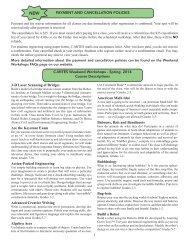
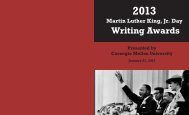
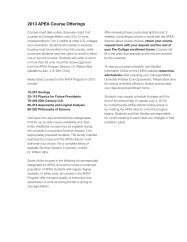

![Pittsburgh Neighborhoods [.pdf] - Carnegie Mellon University](https://img.yumpu.com/22011290/1/190x115/pittsburgh-neighborhoods-pdf-carnegie-mellon-university.jpg?quality=85)
![Curriculum Vitae [.pdf] - Carnegie Mellon University](https://img.yumpu.com/20737100/1/190x245/curriculum-vitae-pdf-carnegie-mellon-university.jpg?quality=85)
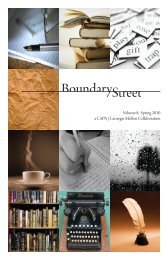
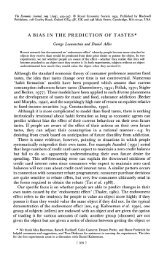
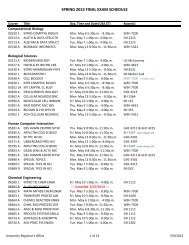
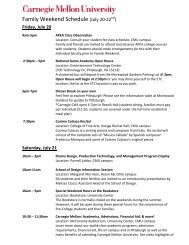
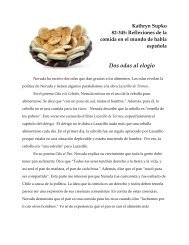

![May 2012 [.pdf] - Carnegie Mellon University](https://img.yumpu.com/12198417/1/190x253/may-2012-pdf-carnegie-mellon-university.jpg?quality=85)
